Exploration of Optimal Reaction Conditions for Constructing Hydrophobic Polymers with Low Deformation to Facilitate the Dimensional Stability of Laminated Bamboo Lumber
Abstract
:1. Introduction
2. Experimental
2.1. Materials
2.2. Synthesis of PHM
2.3. Characterization
2.4. Evaluating the Performance of PHM under Water Immersion
2.5. Construction of PHM in LBL and Its Dimensional Stability
3. Results and Discussion
3.1. The Water Absorption and Swelling Behaviors of PHM
3.2. Characterization of PHM
3.3. Hydrophobicity and Dimensional Stability of the PHM-Modified LBL
3.4. Mechanism of Action of PHM on LBL’s Hydrophobicity and Dimensional Stability
4. Conclusions
Supplementary Materials
Author Contributions
Funding
Institutional Review Board Statement
Informed Consent Statement
Data Availability Statement
Conflicts of Interest
References
- Liu, S.; Gao, D.; Xie, Y.; Chen, B. Experimental Study and Theoretical Analysis of Side-Pressure Laminated Bamboo Lumber Columns under Axial Compression. Sustainability 2022, 14, 11360. [Google Scholar] [CrossRef]
- Kelkar, B.U.; Sharma, S.K.; Shukla, S.R. Comparative Performance of Phenol Formaldehyde-Bonded Laminated Bamboo Lumber and Bamboo Strand Lumber Prepared from Four Different Bamboo Species. J. Trop. For. Sci. 2021, 33, 482–493. [Google Scholar]
- Wang, Z.; Li, H.; Yang, D.; Xiong, Z.; Sayed, U.; Lorenzo, R.; Corbi, I.; Corbi, O.; Hong, C. Bamboo node effect on the tensile properties of side press-laminated bamboo lumber. Wood Sci. Technol. 2021, 55, 195–214. [Google Scholar] [CrossRef]
- Amada, S.; Ichikawa, Y.; Munekata, T.; Nagase, Y.; Shimizu, H. Fiber texture and mechanical graded structure of bamboo. Compos. Part B Eng. 1997, 28, 13–20. [Google Scholar] [CrossRef]
- Wang, F.P.; Li, S.; Wang, L. Fabrication of artificial super-hydrophobic lotus-leaf-like bamboo surfaces through soft lithography. Colloids Surf. A-Physicochem. Eng. Asp. 2017, 513, 389–395. [Google Scholar] [CrossRef]
- Guan, M.; Huang, Z.; Zhu, D. The effect of ultrasonic process on the shear strength and the microstructure of the bonding interface of laminated bamboo lumber. Eur. J. Wood Wood Prod. 2022, 80, 1401–1411. [Google Scholar] [CrossRef]
- Jin, C.D.; Li, J.P.; Han, S.J.; Wang, J.; Sun, Q. A durable, superhydrophobic, superoleophobic and corrosion-resistant coating with rose-like ZnO nanoflowers on a bamboo surface. Appl. Surf. Sci. 2014, 320, 322–327. [Google Scholar] [CrossRef]
- Wang, J.; Wang, H.; Wu, X.; Zhang, Y.; Jiang, J.; Han, S.; Sun, F. Anti-mold activity and reaction mechanism of bamboo modified with laccase-mediated thymol. Ind. Crops Prod. 2021, 172, 114067. [Google Scholar] [CrossRef]
- Chen, J.; Ma, Y.; Lin, H.; Zheng, Q.; Zhang, X.; Yang, W.; Li, R. Fabrication of Hydrophobic ZnO/PMHS Coatings on Bamboo Surfaces: The Synergistic Effect of ZnO and PMHS on Anti-Mildew Properties. Coatings 2019, 9, 15. [Google Scholar] [CrossRef] [Green Version]
- Gao, X.; Su, L.; Jiang, G.; Pang, J.; Lin, L. Dimensional Stability of Lotus Leaf-like Nanostructure Superhydrophobic Bamboo by Modification Using Xylan. Bioresources 2020, 15, 3443–3457. [Google Scholar] [CrossRef]
- Rao, J.; Jiang, J.; Prosper, N.K.; Yang, X.; Liu, T.; Cai, W.; Wang, H.; Sun, F. Combination of polyethylene glycol impregnation and paraffin heat treatment to protect round bamboo from cracking. R. Soc. Open Sci. 2019, 6, 190105. [Google Scholar] [CrossRef] [PubMed] [Green Version]
- Huang, S.; Jiang, Q.; Yu, B.; Nie, Y.; Ma, Z.; Ma, L. Combined Chemical Modification of Bamboo Material Prepared Using Vinyl Acetate and Methyl Methacrylate: Dimensional Stability, Chemical Structure, and Dynamic Mechanical Properties. Polymers 2019, 11, 1651. [Google Scholar] [CrossRef] [PubMed] [Green Version]
- Li, W.; Liu, M.; Zhai, H.; Wang, H.; Yu, Y. Preparing highly durable bamboo materials via bulk furfurylation. Constr. Build. Mater. 2020, 262, 120726. [Google Scholar] [CrossRef]
- Zhang, W.; Zhou, J.; Cao, Z.; Wu, X.; Wang, H.; Han, S.; Zhang, Y.; Sun, F.; Zhang, T. In Situ Construction of Thermotropic Shape Memory Polymer in Wood for Enhancing Its Dimensional Stability. Polymers 2022, 14, 738. [Google Scholar] [CrossRef]
- Wang, Z.X.; Han, X.S.; Wang, S.J.; Lv, Y.; Pu, J. Enhancing the thermal stability, water repellency, and flame retardancy of wood treated with succinic anhydride and melamine-urea-formaldehyde resins. Holzforschung 2020, 74, 957–965. [Google Scholar] [CrossRef]
- Wang, X.Z.; Chen, X.Z.; Xie, X.Q.; Cai, S.; Yuan, Z.; Li, Y. Multi-Scale Evaluation of the Effect of Phenol Formaldehyde Resin Impregnation on the Dimensional Stability and Mechanical Properties of Pinus Massoniana Lamb. Forests 2019, 10, 646. [Google Scholar] [CrossRef] [Green Version]
- Gallorini, M.; Cataldi, A.; Di Giacomo, V. HEMA-induced cytotoxicity: Oxidative stress, genotoxicity and apoptosis. Int. Endod. J. 2014, 47, 813–818. [Google Scholar] [CrossRef]
- Kwon, S.; Oh, K.; Shin, S.J.; Lee, H.L. Effects of hydroxyethyl methacrylate comonomer in styrene/acrylate latex on coating structure and printability. Prog. Org. Coat. 2020, 147, 105862. [Google Scholar] [CrossRef]
- Liang, X.-Y.; Wang, L.; Wang, Y.-M.; Ding, L.-S.; Li, B.-J.; Zhang, S. UV-Blocking Coating with Self-Healing Capacity. Macromol. Chem. Phys. 2017, 218, 1700213. [Google Scholar] [CrossRef]
- Wu, H.; Yang, X.; Rao, J.; Zhang, Y.; Sun, F. Improvement of Bamboo Properties via In Situ Construction of Polyhydroxyethyl Methylacrylate and Polymethyl Methylacrylate Networks. Bioresources 2018, 13, 6–14. [Google Scholar] [CrossRef]
- Huang, Y.; Li, G.; Chu, F. In situ polymerization of 2-hydroxyethyl methacrylate (HEMA) and 3-(methacryloxy)propyltrimethoxysilane (MAPTES) in poplar cell wall to enhance its dimensional stability. Holzforschung 2019, 73, 469–474. [Google Scholar] [CrossRef]
- Redfearn, H.N.; Goddard, J.M. Antioxidant and dissociation behavior of polypropylene-graft-maleic anhydride. J. Appl. Polym. Sci. 2022, 139, 10. [Google Scholar] [CrossRef]
- Techawinyutham, L.; Frick, A.; Siengchin, S. Polypropylene/Maleic Anhydride Grafted Polypropylene (MAgPP)/Coconut Fiber Composites. Adv. Mech. Eng. 2016, 8, 9. [Google Scholar] [CrossRef] [Green Version]
- Essoua, G.G.E.; Blanchet, P.; Landry, V.; Beauregard, R. Maleic Anhydride Treated Wood: Effects of Drying Time and Esterification Temperature on Properties. Bioresources 2015, 10, 6830–6860. [Google Scholar] [CrossRef] [Green Version]
- Teaca, C.A.; Bodirlau, R.; Spiridon, I. Maleic anhydride treatment of softwood-effect on wood structure and properties. Cellul. Chem. Technol. 2014, 48, 863–868. [Google Scholar]
- He, M.M.; Xu, D.D.; Li, C.G.; Ma, Y.; Dai, X.; Pan, X.; Fan, J.; He, Z.; Gui, S.; Dong, X.; et al. Cell Wall Bulking by Maleic Anhydride for Wood Durability Improvement. Forests 2020, 11, 11. [Google Scholar] [CrossRef] [Green Version]
- El Nazer, H.A.; Elgohary, E.A.; Rabie, S.T. Photostability, thermal and mechanical properties of poly(vinyl chloride)/novel acrylate terpolymer blend. J. Vinyl Addit. Technol. 2018, 25, E55–E62. [Google Scholar] [CrossRef]
- Mahmoodzadeh, F.; Ghorbani, M.; Jannat, B. Glutathione and pH-responsive chitosan-based nanogel as an efficient nanoplatform for controlled delivery of doxorubicin. J. Drug Deliv. Sci. Technol. 2019, 54, 101315. [Google Scholar] [CrossRef]
- Zhang, W.P.; Lu, Y.H.; Khanal, S.; Xu, S.A. Effects of compatibilizers on selected properties of hdpe composites highly filled with bamboo flour. Wood Fiber Sci. 2018, 50, 254–264. [Google Scholar] [CrossRef] [Green Version]
- Pavarelli, G.; Ochoa, J.V.; Caldarelli, A.; Puzzo, F.; Cavani, F.; Dubois, J.-L. A New Process for Maleic Anhydride Synthesis from a Renewable Building Block: The Gas-Phase Oxidehydration of Bio-1-butanol. ChemSusChem 2015, 8, 2250–2259. [Google Scholar] [CrossRef]
- Pamfil, D.; Schick, C.; Vasile, C. New Hydrogels Based on Substituted Anhydride Modified Collagen and 2-Hydroxyethyl Methacrylate. Synthesis and Characterization. Ind. Eng. Chem. Res. 2014, 53, 11239–11248. [Google Scholar] [CrossRef]
- Shogren, R.L. Rapid preparation of starch esters by high temperature/pressure reaction. Carbohydr. Polym. 2003, 52, 319–326. [Google Scholar] [CrossRef]
- He, W.-S.; Ma, Y.; Pan, X.-X.; Li, J.-J.; Wang, M.-G.; Yang, Y.-B.; Jia, C.-S.; Zhang, X.-M.; Feng, B. Efficient Solvent-Free Synthesis of Phytostanyl Esters in the Presence of Acid-Surfactant-Combined Catalyst. J. Agric. Food Chem. 2012, 60, 9763–9769. [Google Scholar] [CrossRef]
- Liu, Y.-w.; Wang, P.; Wang, J.; Xu, B.; Xu, J.; Yuan, J.-G.; Yu, Y.-Y.; Wang, Q. Transparent and tough poly(2-hydroxyethyl methacrylate) hydrogels prepared in water/IL mixtures. New J. Chem. 2020, 44, 4092–4098. [Google Scholar] [CrossRef]
- Yan, S.; Gao, X.; Wang, Z.; Gao, C. Antifouling and antibacterial improvement of surface-functionalized poly(vinylidene fluoride) membrane prepared via dihydroxyphenylalanine-initiated atom transfer radical graft polymerizations. J. Membr. Sci. 2012, 394, 107–119. [Google Scholar]
- Ptak, S.; Zarski, A.; Antczak, T.; Kapusniak, J. Esterification of potato starch with oleic acid in the presence of lipase from Candida antarctica in a microwave field and under conventional heating. Polimery 2016, 61, 442–448. [Google Scholar] [CrossRef]
- Mahmoodian, H.; Moradi, O.; Shariatzadeha, B.; Salehf, T.A.; Tyagi, I.; Maity, A.; Asif, M.; Gupta, V.K. Enhanced removal of methyl orange from aqueous solutions by poly HEMA–chitosan-MWCNT nano-composite. J. Mol. Liq. 2015, 202, 189–198. [Google Scholar] [CrossRef]
- Nassar, N.; Whitehead, F.; Istivan, T.; Shanks, R.; Kasapis, S. Manipulation of the Glass Transition Properties of a High-Solid System Made of Acrylic Acid-N,N′-Methylenebisacrylamide Copolymer Grafted on Hydroxypropyl Methyl Cellulose. Int. J. Mol. Sci. 2021, 22, 2682. [Google Scholar] [CrossRef]
- Muoz-García, R.O.; Hernández, M.E.; Ortiz, G.G.; Fernández, V.V.; Arellano, M.R.; Sánchez-Díaz, J.C. A novel polyacrylamide-based hydrogel crosslinked with cellulose acetate and prepared by precipitation polymerization. Química Nova 2019, 38, 1031–1036. [Google Scholar]
- Kariper, I.A. The Release of Doxorubicin’s Active Ingredient from the Hydrogels with Poly (HEMA/Acrylamide/Itaconic acid) and Their Biological Function. Indian J. Pharm. Educ. Res. 2017, 51, 401–406. [Google Scholar] [CrossRef] [Green Version]
- Gupta, V.K.; Tyagi, I.; Agarwal, S.; Sadegh, H.; Shahryari-ghoshekandi, R.; Yari, M.; Yousefi-nejat, O. Experimental study of surfaces of hydrogel polymers HEMA, HEMA–EEMA–MA, and PVA as adsorbent for removal of azo dyes from liquid phase. J. Mol. Liq. 2015, 206, 129–136. [Google Scholar] [CrossRef]
- Esselin, N.; Portolan, F.; Domloge, N.; Clark, R.B.; Musa, O.M.; Pilard, J.-F. Offline Monitoring of Hydroxyethyl Methacrylate and 3-Dimethylaminopropyl Methacrylamide Copolymerization: Correlation between FTIR and GC Quantifications. Spectrosc. Lett. 2015, 48, 53–58. [Google Scholar] [CrossRef]
- Dagys, L.; Klimkevičius, V.; Klimavicius, V.; Aidas, K.; Makuška, R.; Balevicius, V. CP MAS kinetics in soft matter: Spin diffusion, local disorder and thermal equilibration in poly(2-hydroxyethyl methacrylate). Solid State Nucl. Magn. Reson. 2020, 105, 101641. [Google Scholar] [CrossRef] [PubMed]
- Karakus, G.; Zengin, H.B.; Polat, Z.A.; Yenidunya, A.F.; Aydin, S. Cytotoxicity of three maleic anhydride copolymers and common solvents used for polymer solvation. Polym. Bull. 2013, 70, 1591–1612. [Google Scholar] [CrossRef]
- Fu, H.; Yan, C.; Wei, X. Study on Chlorination of Maleic Anhydride Grafted Polypropylene. Polym. Polym. Compos. 2013, 21, 123–128. [Google Scholar] [CrossRef]
- Prashantha, K.; Rashmi, B.J.; Lee, J.H. Preparation and characterization of carbon nanotube filled poly (2-hydroxyethylmethacrylate) nanocomposites. High Perform. Polym. 2013, 25, 97–103. [Google Scholar] [CrossRef]
- Huang, Y.Q.; Yu, Y.; Zhang, C.; Wang, X.; Yang, Z.; Yang, Y. Investigation of the relationship between surface colour, contact angle and chemical properties of heat-treated bamboo. Wood Mater. Sci. Eng. 2022, 783–791. [Google Scholar] [CrossRef]
- Li, T.; Cheng, D.L.; Walinder, M.E.P.; Zhou, D.-G. Wettability of oil heat-treated bamboo and bonding strength of laminated bamboo board. Ind. Crops Prod. 2015, 69, 15–20. [Google Scholar] [CrossRef]
- Lee, S.H.; Wang, S. Biodegradable polymers/bamboo fiber biocomposite with bio-based coupling agent. Compos. Part A Appl. Sci. Manuf. 2006, 37, 80–91. [Google Scholar] [CrossRef]
- Geng, Y.; Pei, X.; He, X.; Li, P.; Wu, Y.; Zuo, Y. Preparation and Characterization of Esterified Bamboo Flour by an In Situ Solid Phase Method. Polymers 2018, 10, 920. [Google Scholar] [CrossRef] [Green Version]
- Guo, X.; Wu, Y.; Yan, N. In situ micro-FTIR observation of molecular association of adsorbed water with heat-treated wood. Wood Sci. Technol. 2018, 52, 971–985. [Google Scholar] [CrossRef]
- Wang, Y.; Huang, Y.; Xue, J.; Peng, Y.; Cao, J. Effects of heat treatment temperatures on the photostability of Moso bamboo during accelerated UV weathering. Wood Mater. Sci. Eng. 2021, 17, 823–833. [Google Scholar] [CrossRef]
- Mokhena, T.C.; John, M.J. Esterified cellulose nanofibres from saw dust using vegetable oil. Int. J. Biol. Macromol. 2020, 148, 1109–1117. [Google Scholar] [CrossRef] [PubMed]
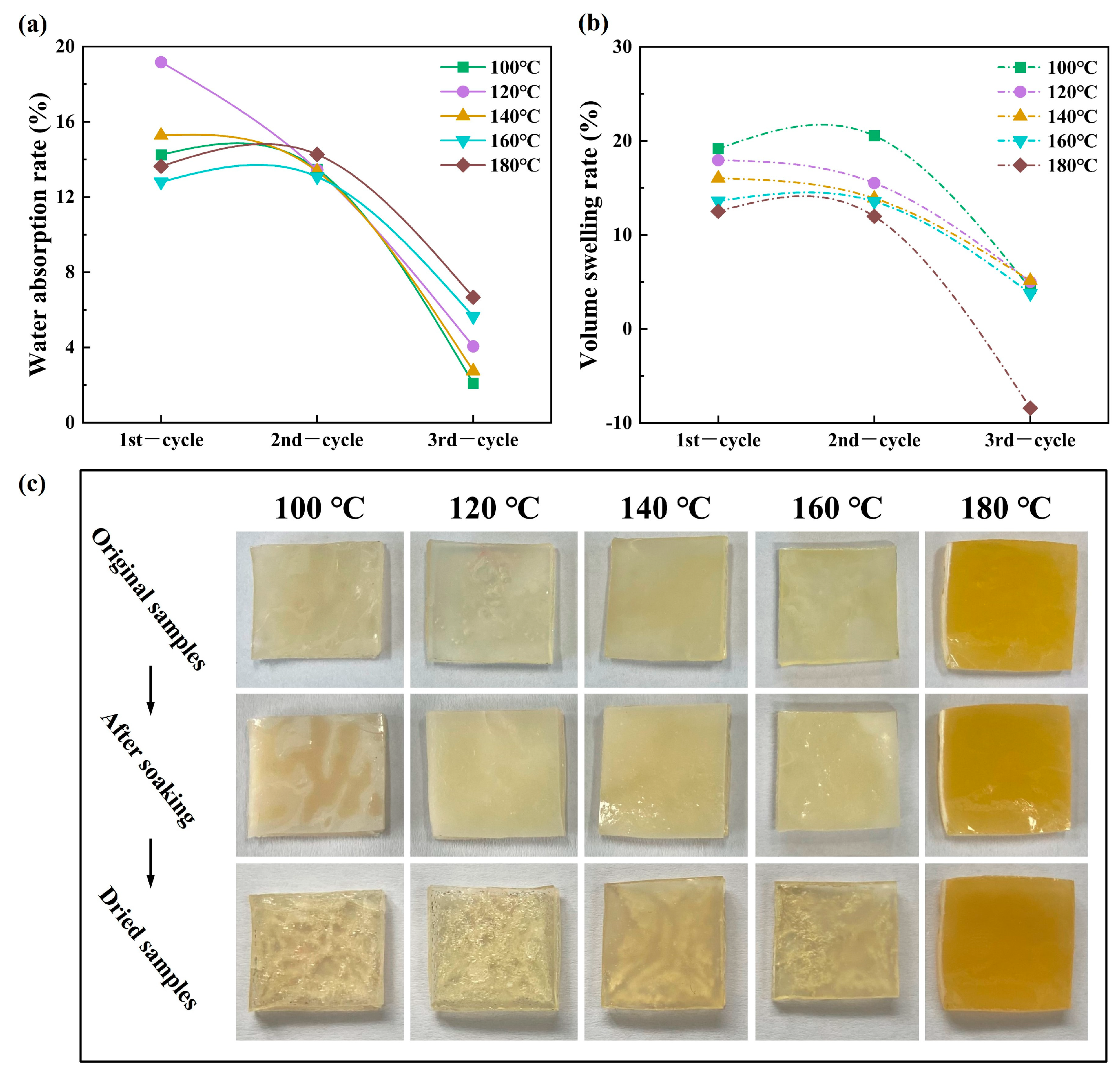

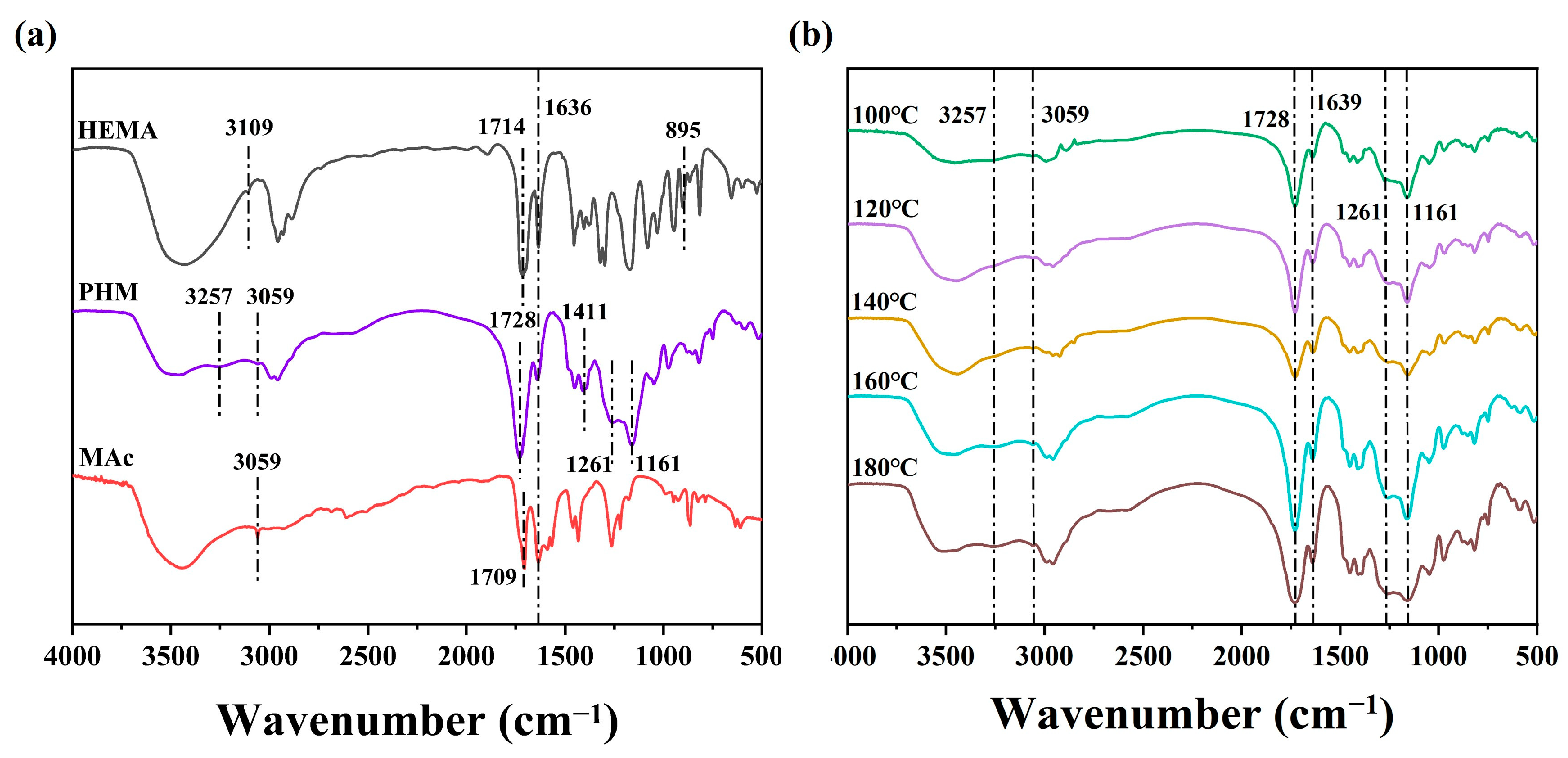


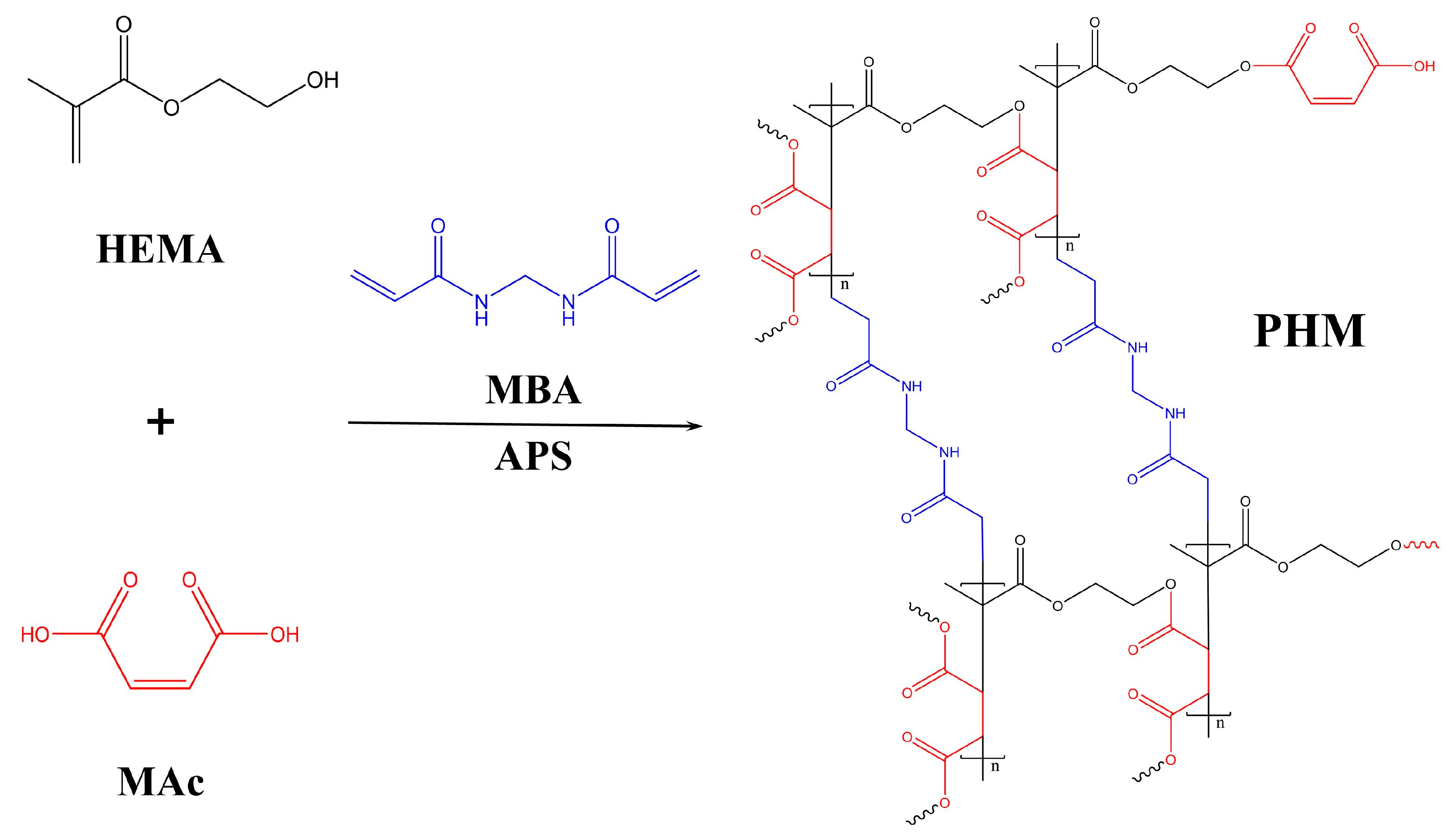
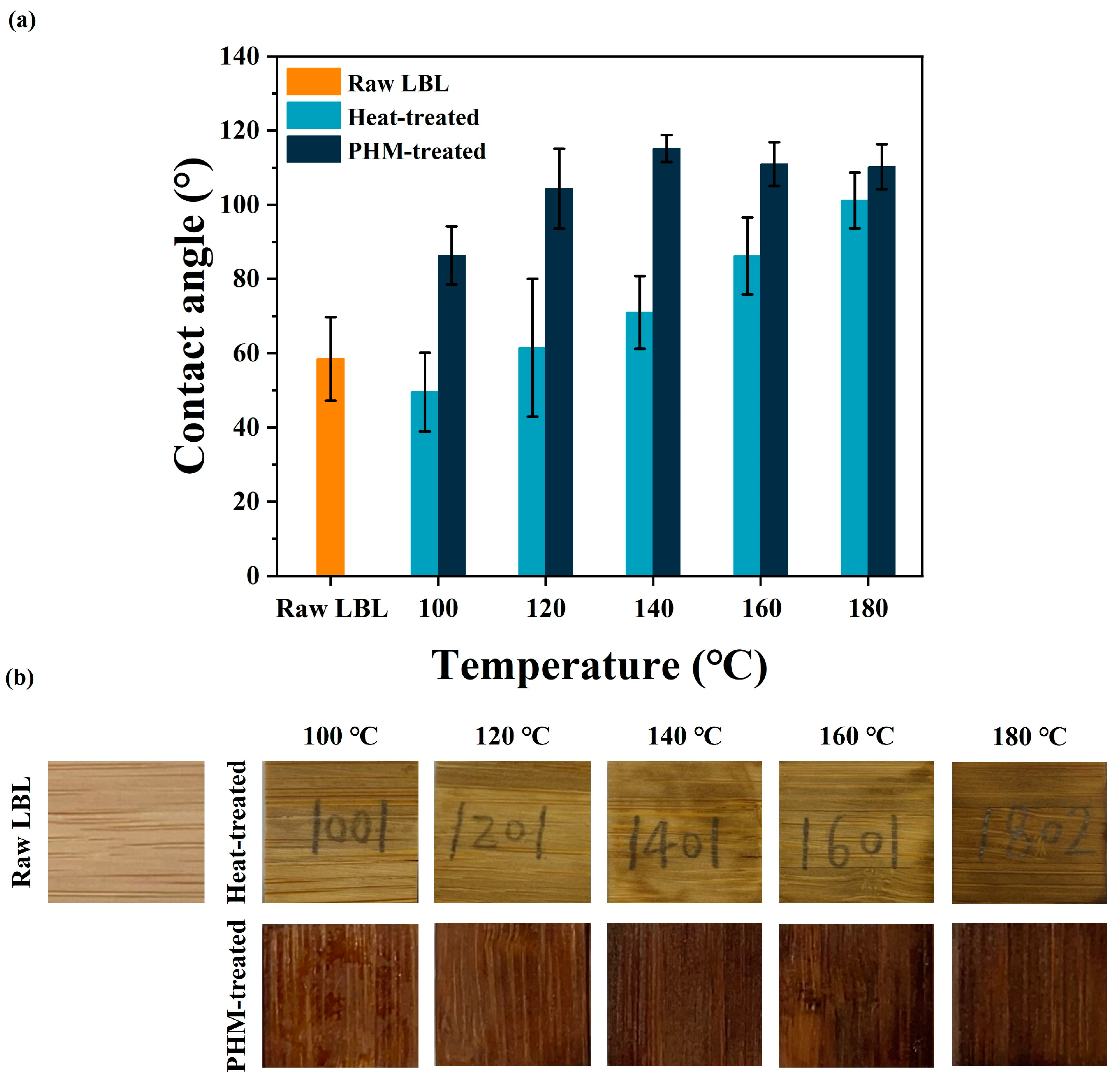
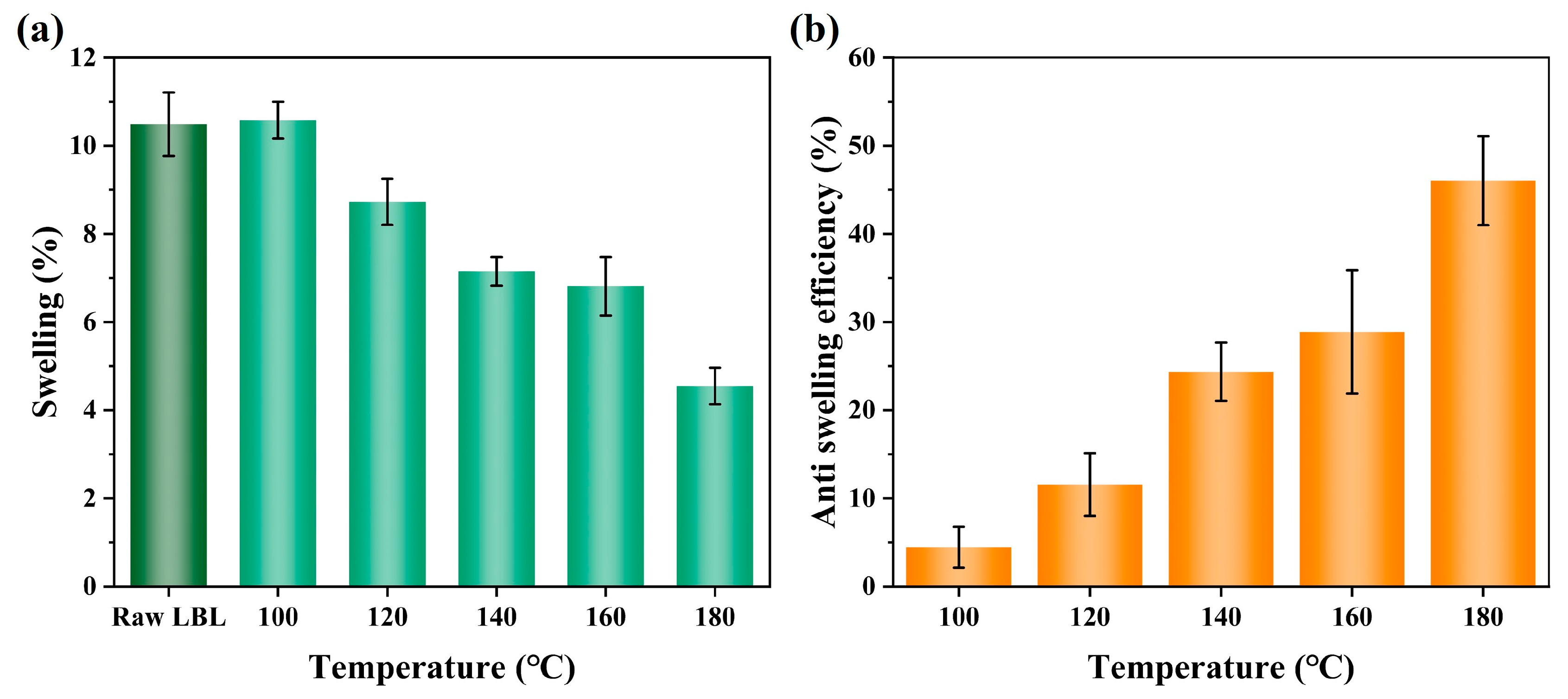
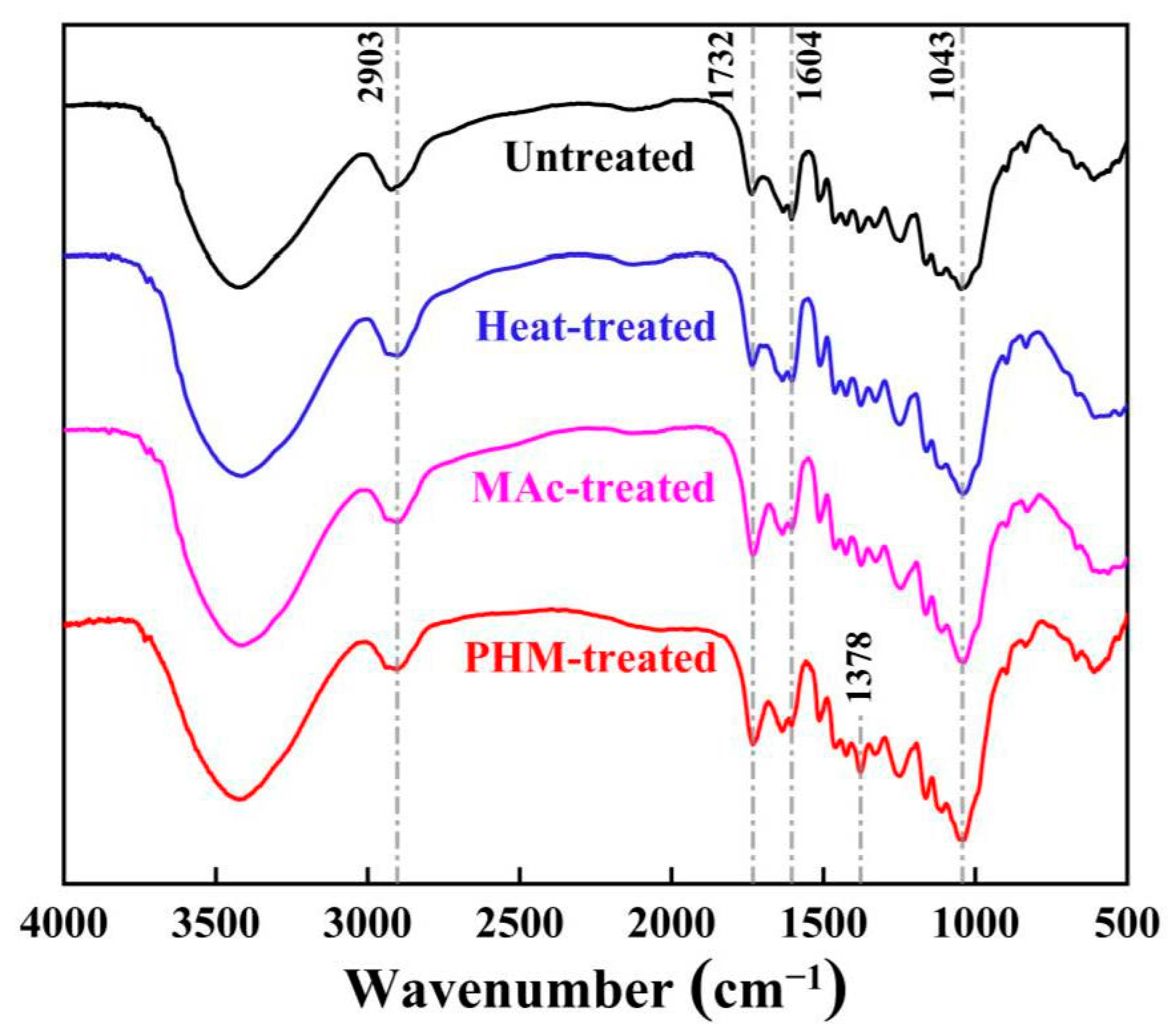

| Sample | Temperature (°C) | VG (%/%) | ML (%) |
|---|---|---|---|
| PHM-100 | 100 | 1.70 ± 0.34 | 0.85 ± 0.64 |
| PHM-120 | 120 | 1.01 ± 0.31 | 6.65 ± 0.72 |
| PHM-140 | 140 | 1.66 ± 0.68 | 4.46 ± 1.08 |
| PHM-160 | 160 | 1.09 ± 0.47 | 1.85 ± 0.30 |
| PHM-180 | 180 | 0.75 ± 0.67 | 5.50 ± 1.32 |
Disclaimer/Publisher’s Note: The statements, opinions and data contained in all publications are solely those of the individual author(s) and contributor(s) and not of MDPI and/or the editor(s). MDPI and/or the editor(s) disclaim responsibility for any injury to people or property resulting from any ideas, methods, instructions or products referred to in the content. |
© 2023 by the authors. Licensee MDPI, Basel, Switzerland. This article is an open access article distributed under the terms and conditions of the Creative Commons Attribution (CC BY) license (https://creativecommons.org/licenses/by/4.0/).
Share and Cite
Zhou, J.; Jin, L.; Wu, X.; Wang, H.; Han, S.; Zhang, Y.; Sun, F. Exploration of Optimal Reaction Conditions for Constructing Hydrophobic Polymers with Low Deformation to Facilitate the Dimensional Stability of Laminated Bamboo Lumber. Polymers 2023, 15, 2637. https://doi.org/10.3390/polym15122637
Zhou J, Jin L, Wu X, Wang H, Han S, Zhang Y, Sun F. Exploration of Optimal Reaction Conditions for Constructing Hydrophobic Polymers with Low Deformation to Facilitate the Dimensional Stability of Laminated Bamboo Lumber. Polymers. 2023; 15(12):2637. https://doi.org/10.3390/polym15122637
Chicago/Turabian StyleZhou, Jianchao, Li Jin, Xinxing Wu, Hui Wang, Shuaibo Han, Yan Zhang, and Fangli Sun. 2023. "Exploration of Optimal Reaction Conditions for Constructing Hydrophobic Polymers with Low Deformation to Facilitate the Dimensional Stability of Laminated Bamboo Lumber" Polymers 15, no. 12: 2637. https://doi.org/10.3390/polym15122637





